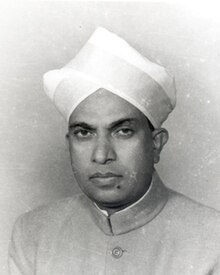Kengal Hanumanthaiah
This article needs additional citations for verification. (January 2008) |
Kengal Hanumanthaiah ಕೆಂಗಲ್ ಹನುಮಂತಯ್ಯ | |
|---|---|
 | |
| 2nd Chief Minister of Mysore State | |
| In office 30 March 1952 – 19 August 1956 | |
| Preceded by | K. C. Reddy |
| Succeeded by | Kadidal Manjappa |
| Member of the Indian Parliament for Bangalore City | |
| In office 2 April 1962 – 18 January 1977 | |
| Preceded by | N. Keshavaiengar |
| Succeeded by | C. K. Jaffer Sharief |
| Personal details | |
| Born | K. Hanumanthaiah 14 February 1908 Lakkappanahalli, Ramanagara, Karnataka, India |
| Died | 1 December 1980 (aged 72) |
| Resting place | K. Hanumanthaiah |
| Political party | Indian National Congress |
| Parent |
|
Kengal Hanumanthaiah (15 February 1908 – 1 December 1980), also spelt as Kengal Hanumanthaiya, was the second Chief Minister of Karnataka (then, Mysore State) from 30 March 1952 to 19 August 1956. He contributed to the construction of Vidhana Soudha, the seat of the state legislature.
Early life
Kengal Hanumanthaiah was born on February 14, 1908 in a Vokkaliga family in a Lakkappanahalli, a small village near Ramanagara district, Bangalore. He graduated in Arts from the Maharaja College in Mysore in 1930 and later earned a degree in Law from Poona Law College in 1932. During his college days, he was elected as the Secretary of the Students Union and the Karnataka Sangha. After his graduation, he joined the bar council in the same year.[1]
Political career
At that time, the independence movement was steadily growing and at the center stage of the movement was the Indian National Congress led by Mahatma Gandhi. Dr. P. Tandon, the then President of Indian National Congress, advised Hanumanthaiah to give up his active practice at the bar and to devote himself to the freedom struggle. With the inspiration of Gandhiji and the persuasion of Tandon, Hanumanthaiah joined the freedom movement and became active in the then Mysore Congress. During the movement, he was jailed more than 9 times. He was unanimously elected as the leader of the Parliamentary Party wing of the Congress Party in Mysore Assembly in the year 1948. Also, he was a member of the Constituent Assembly of India.[2]
He became the second Chief minister of Mysore state in 1952, following the victory of the Congress party in the 1st general elections. His tenure as Chief Minister was marked by activities aimed at uplifting the rural population of the state and promoting economic growth.[3] Hanumanthaiah's major achievemnet was the construction of the "Vidhana Soudha", the largest legislature-cum-office building in India at that time. His other key achievement was the Unification of Karnataka. He played a role in uniting the Kannada speaking areas within the boundaries of a single state.[2][2]
Role in Constituent Assembly[4]
He was part of the Drafting Committee.[5] In the Constituent Assembly, he argued for greater autonomy for states.[6]
Vidhan Soudhaa

During an interview, Kengal Hanumanthaiah explained the reasoning behind the construction of a grand legislature building. A Russian cultural delegation was visiting Bangalore and Hanumanthaiah took them around to show the city. Stung by their comments, Hanumanthaiah vowed to create a monument so magnificent that it would showcase the best of Karnataka's indigenous architectural style. This resulted in the Vidhana Soudha, the seat of Legislature in Karnataka.[7]
Later life
After resigning as Chief Minister shortly before the Unification of Karnataka in 1956, he moved on to national politics. He was continuously elected as a member of parliament representing Bangalore city from 1962 to 1977. During this period he served as minister in the Union cabinet handling a number of portfolio's such as Railways, Industries etc. In the 1971 elections, he defeated the poet Gopalkrishna Adiga, who was a candidate of the Jana Sangh. However, he lost to Justice K. S. Hegde of the Janata party in 1977. He died on 1 December 1980.
Legacy
The Kengal Hanumanthaiya Memorial Trust celebrated his 104th birthday in 2012 which had the Chief Guest, the 13th President (then Finance Minister), Pranab Mukherjee[8]
A statue of Hanumanthaiah has been installed in front of the Vidhana Soudha.[9] His centenary celebrations were held in the year 2008.[10]
See also
References
- ^ "Kengal Hanumanthaiah". Vokkaligara Sangha.
- ^ a b c "Kengal Hanumanthaiah – Karnataka's second Chief Minister". Karnataka Spider.
- ^ "The Political Powerhouse – Kengel Hanumanthaiah". Karnataka.com.
- ^ "CADIndia". cadindia.clpr.org.in. Retrieved 16 January 2018.
- ^ "CADIndia". cadindia.clpr.org.in. Retrieved 16 January 2018.
- ^ "CADIndia". cadindia.clpr.org.in. Retrieved 16 January 2018.
- ^ "Vidhan Soudha". Bangalore Best. Archived from the original on 6 June 2009.
{{cite web}}: Unknown parameter|deadurl=ignored (|url-status=suggested) (help) - ^ "Archived copy". Archived from the original on 4 March 2016. Retrieved 30 October 2015.
{{cite web}}: Unknown parameter|deadurl=ignored (|url-status=suggested) (help)CS1 maint: archived copy as title (link) - ^ "Kengal Hanumanthaiah's statue". Times of India.
- ^ "Rich tributes paid to Kengal Hanumanthaiah". Mangalorean.Com. Archived from the original on 3 March 2016.
{{cite web}}: Unknown parameter|deadurl=ignored (|url-status=suggested) (help)
- 1908 births
- 1980 deaths
- Railway Ministers of India
- Politicians from Bangalore
- Kannada people
- 3rd Lok Sabha members
- Maharaja's College, Mysore alumni
- Members of the Constituent Assembly of India
- 4th Lok Sabha members
- 5th Lok Sabha members
- Lok Sabha members from Karnataka
- Chief ministers from Indian National Congress
- Indian National Congress politicians
